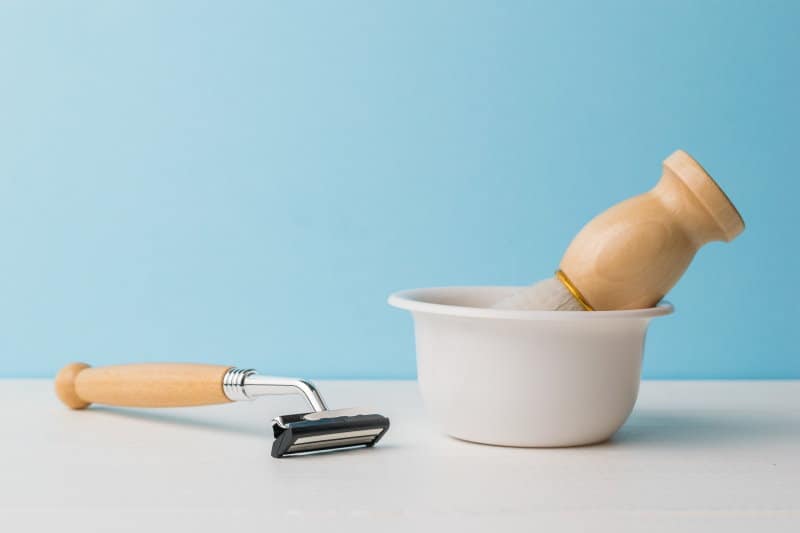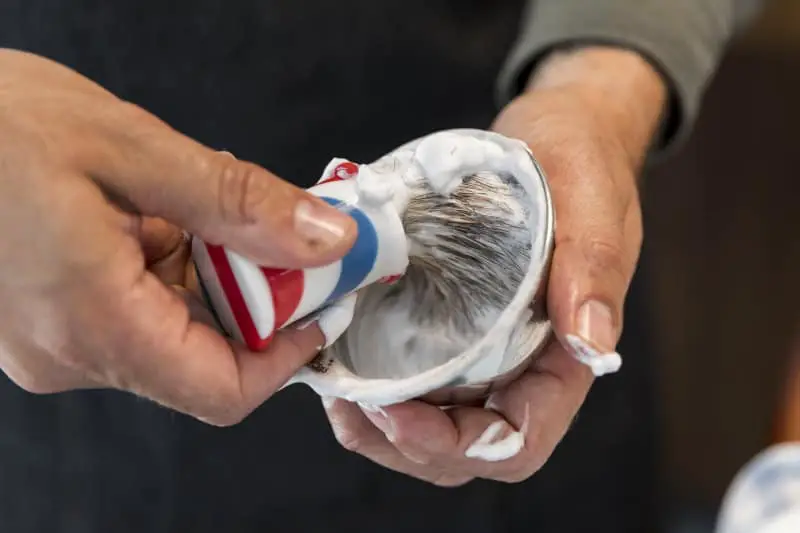Not long ago, shaving was a dispiriting experience for a young man. You hit puberty, and someone gave you a disposable Bic razor and a bottle of Gillette foam. The foam smelled like nothing, and the razor went rusty immediately. Things are better now; even a young guy shaving for the first time can work with a decent razor, maybe even a double-sided safety or a straight razor. Classic shaving soap, applied with cup and brush, is back, too, and the most affordable shaving soap on the market is an all-time classic: Williams Mug Shaving Soap.
For its minuscule price, William’s Mug Shaving Soap is a steal. It lacks the bells, whistles, and high-end ingredients of pricier brands. It’s also tallow-based, which comes with some skincare risks. Overall, it’s a good match for new shavers on a budget.
Here is our full review of Williams Mug Shaving Soap. With a lot of history and some solid field research, we will tell you what to expect from this storied product.
The Long, Meandering History of Williams
It’s kind of amazing to look at a product like Williams Mug Shaving Soap, which has undergone almost no composition or marketing changes in the last 180 years. Consider a recent eBay sale of a vintage box of Williams Mug Shaving Soap. Now, compare that to the contemporary product on Amazon. The items are virtually identical.
So, wouldn’t a product that hasn’t changed over the years have to be great? To determine the answer, let’s begin by establishing the Williams brand’s historic bona fides.
Patriotic Beginnings
The Williams Company (first called Williams and Brothers) was founded in 1840. It was the production venture of general store owner James Baker Williams of Lebanon, Connecticut. One of his ancestors signed the Declaration of Independence. Williams’ first product was Genuine Yankee Soap. This soap took off, and by 1885, the Williams Company had relocated 30 miles west to Glastonbury and expanded to a full slate of washing and shaving products. The Williams factory was the first in America to employ women.
Among the company’s products was a shaving soap stick which retailed for 25 cents and promised “Richness of LATHER, Delicacy of PERFUME, and superior strength and Style of Package.”
In an interesting side note, one of J.B. Williams’ first products was a sweet-smelling, inexpensive white bath soap he called Ivorine. More interested in focusing on his shaving line, Williams sold the product to new Cincinnati-based soap and candle company called Proctor and Gamble. That product became Ivory soap, which you could argue has been more lucrative than the shaving products Williams chose to focus on.
A Top Choice for Shavers
While it’s a niche brand today, Williams was a force to be reckoned with in the 19th-century New England men’s grooming scene. Advertisements indicate that Williams products were the official shaving soaps of the US Navy. In 1857, Williams had to sue a New York-based manufacturer for producing and selling an inferior counterfeit version of Yankee Soap. Such was the popular appeal of their wares.
In 1912, the company trademarked its MUG brand, and soon the iconic Mug Shaving Soap box became a pharmacy staple. By the 1950s, the company had invested in countless other American-standard personal care products like Skol suntan oil and Aqua Velva aftershave.
Williams in the Modern Era
Williams continued as a family-owned until 1957 (J.B. Williams died in 1907). Then, it went through a series of acquisitions. The family sold to the New York-based Pharmaceuticals, Inc, which in turn sold it to Nabisco in 1971. Today, the brand is part of the Combe stable, owner of such product imprints as Just for Men, Vagisil, and Seabond.
Despite some premature rumors of its demise, the Williams Shaving Soap brand continues unabated. It is still available on Amazon and at national chains like Wegmans, Kroger, Walmart, and Walgreens. Their shaving soap is still packaged in a retro-looking blue and white box with its instantly recognizable frothy mug logo.
Williams’ Reputation on the Street

In total, Williams Mug Shaving Soap has a contradictory reputation among shavers. It regularly appears on lists of the top shaving soaps on the market, and there are guys out there that hoard pucks of Williams the was Elaine Benes stockpiled sponges.
On the other hand, there’s an equally vocal contingent that swears Williams is atrocious. Even some guys that like the stuff claim it is not especially high quality.
There’s little doubt that the most appealing thing about Williams Mug Shaving Soap is its price. It is the cheapest shaving soap out there, rarely retailing for more than a couple dollars. Not bad for a product that can trace its lineage back to America’s founding (or close to it, anyway).
The question remains: is Williams Mug Shaving Soap a cost-effective option, or is it just cheap?
To answer that, we lathered up and took some notes…
What is Williams Mug Shaving Soap Made From?
We’re not going to lie: we half-expected this shaving soap to be a mix of chalk, rock salt, and lye. It was a pleasant surprise to see that it includes some decent ingredients:
- Sodium Cocoate is the foaming component of coconut oil.
- Potassium Stearate is used for lubrication.
- Glycerin draws moisture to the surface of your skin for a smooth shave.
These ingredients, plus water, comprise four of the five most prominent components of Williams Mug Shaving Soap. It isn’t exactly the whole-ingredient, spa-quality men’s grooming product that modern beardsmen love. Then again, it costs a fraction of what most men’s face products do these days, so we perhaps shouldn’t be surprised it doesn’t have raw jojoba oil in it.
Strangely, the packaging states that it “May also contain Sodium Palm Kernelate.” Palm kernel oil is an amazing anti-aging and skin-soothing oil common in high-end shaving products. Its inclusion would be quite reassuring. That Williams uses the qualifier may in its ingredient listing makes you wonder how much of this is in there.
Unfortunately, the second most prevalent ingredient in Williams Mug Shaving Soap is tallow. As we’ve established in a prior post, since tallow is a rendered fat product, it can accumulate toxins the originating animal was exposed to.
Besides these ingredients, Williams is mostly a mash of fragrance and stabilizing chemicals.
How Does Williams Mug Shaving Soap Smell?

If you frequent many men’s grooming forums, you will notice the term citronella often applied to this soap. One whiff, and it’s clear where those assessments come from.
There’s nothing subtle or subdued about Williams Mug Soap. Its top notes, which linger longer than a more balanced product would, are fresh squeezed lemon or grapefruit. Underneath is something between allspice and rose petal. At the base is musk, which feels closer to a contemporary shaving lather: sandalwood or cedar.
It’s not an objectionable combination of fragrances by any stretch. It’s just massively unbalanced. The citrus and musk seem to be doing battle, while the spicy middle notes shuffle off to the background.
If you ever joined your father in an old-school barbershop where the old guys did hot razor shaves, this mix of smells will be familiar.
We think, despite its sledgehammer lack of subtlety, Williams’ aroma is a big part of the product’s unique charm. If you learned to shave during the Barbasol or Gillet shaving cream era, you probably used a product that smelled like menthol or like nothing. Today, you might expect well-curated aroma profiles full of cedar, pine needle, orange, and chamomile.
Williams Mug Shaving Soap doesn’t smell like anything from the last forty years. It smells like the type of hot towel, straight razor shave your grandfather got before an Elks meeting. We think that sounds like some nice olfactory nostalgia.
How Does Williams Mug Shaving Soap Work on Your Face?
This is what really matters. Forget the price and the history. Forget the forums and the product comparisons. Does Williams Mug Shaving Soap do well in the field?
Here is our assessment of the shaving puck’s strengths and weaknesses.
Lather Stability
Despite the packaging promising “For a lasting lather,” many prominent men’s grooming reviewers have complained that its lather is thin and unstable. It indeed takes some work to get a lather going with Williams. You’ll need to wet it down more than most shaving soaps. That, in turn, can lead to larger bubbles in your lather. A recurring issue in online reviews is Williams Shaving Soap lather fading so fast on guys’ faces that they can’t get a razor to it.
We did not experience such an issue using a basic wet brush technique. That being said, it took some serious elbow grease to work the soap into our brush. Even when we managed a functional lather, it was far from robust. But it coated the skin well and stuck around for the shave.
Slickness and General Feel
Once the lathered-up Williams Mug Soap hit the cheek, it provided a reasonably slick, clean shave. Working over a few day’s stubble, a quality safety razor moved quickly and evenly. There was a reassuring softness and effervescence to the lather that lasted through the whole shave.
With that said, it’s not hard to imagine that, with even a little more water, William’s Mug Soap could become a frothy, ineffective mess. That wasn’t our experience, though. With a conservative wetness in the brush, the soap was resilient, slick, and full on the skin.
Protection
This is where using a bargain-rate shaving soap can feel unnerving. Lather stability and slickness are important to a satisfying shave, but if your skin isn’t protected, things can get hairy (pardon the expression).
Luckily, Williams Mug Shaving Soap’s full-bodied lather provided adequate protection for a safety razor shave. We were able to do multiple passes over the same skin without cuts, catches, or irritation.
At this point, we could conceivably call this product a net winner. It might not be the finest quality shaving soap out there, but it gets the job done. However, if you’re reading this blog, you value the health and vitality of your face. As such, we need to discuss…
Hydration
If there’s a real disappointment to Williams Mug Shaving Soap, it has to do with moisturizing.
While there’s no requirement that a shaving product also hydrates your newly shorn face, there are many men’s grooming products that do just that. Granted, those products generally cost more than two dollars.
Despite the limited presence of coconut and palm kernel oils, Williams leaves the face feeling smooth but parched. You will be reaching for a good shave balm or face moisturizer right after shaving. In fact, you might want to think ahead about what balm flavors will pair with Williams’ unique smell.
Washability
This might not matter as much for a fresh-faced shaver, but beardsmen are always on the lookout for a shaving product that washes out easily. When you have a mountain-man pelt on your cheeks, maneuvering your shaving product only where it’s needed requires safe-cracker delicacy.
One of the pros of using a decent shave soap is that its residue blends pleasantly into facial hair with a little water. It is nice not having to worry about clumps of hardening gel or cream in your beard.
Unfortunately, Williams Mug Soap requires as much elbow grease to wash away as it did to lather up at the beginning. You might find yourself dousing your face multiple times over to rid yourself of the leftover suds.
That’s not ideal, but this residue is surprisingly easy on the nose. That overwhelming citrus-candle scent you get off the puck is just a faint memory, fading into the floral and earthy notes underneath.
Is Williams Mug Shaving Soap a Good Value?

We know that Williams Mug Soap is inexpensive, but is it the most cost effective soap on the market?
We would have to say, yes, it is. For the pittance you’ll pay for a 1.75-ounce disk of Williams, you can manage between 50 and 75 decent shaves. It is all but impossible to find a better deal than that on shaving soap.
Are we suggesting you go out right now and buy Williams Shaving Soap? Not quite. Slow down there, chief.
The bottom line on this product is that it gets the job done at an insanely low price point. If that low bar is enough for you, this is your brand. It would be impossible for us to call a Williams Mug Soap shave high quality.
Here are some pros and cons to consider concerning the shave itself:
| Pros | Cons |
|
|
The pros in that list are basically table-stakes for a block of shaving soap, but the cons might be deal-breakers.
If you’re interested in securing some Williams Mug Shaving Soap, you can purchase a case here.
Other Low-Cost Shaving Soap Options
You might be left with the impression that there are only two types of shaving soap out there: expensive high-quality soap and bargain-basement utility soap.
That is not the case. Many fine soaps offer superior shaves without breaking the bank. Let us offer a few excellent alternatives for your blade, brush, and bowl.
- Henry Cavendish Himalaya Shaving Soap – Cavendish shaving products are super-popular and often sold out. That’s not surprising. This affordable shea butter soap incorporates musky, forest-y aromas and three top-tier emollient oils: coconut, castor, and safflower. Your shorn face will be soft and sweet-smelling.
- Van Der Hagen Scented Shave Soap – Van Der Hagen makes one of our favorite badger-hair shaving brushes, and their low-cost soap is excellent as well. A high sorbitol and glycerin content makes the lather slick and soft. Shea, mango, and cocoa butters will leave your face moisturized. The scent is sweet and subtle.
- Proraso Shaving Soap in a Bowl, Sensitive Skin – This Italian shaving company makes one fine, affordable product. With a high water content, this soap lathers fast and fully. Coconut oil makes for a smooth, hydrating shave, and a mélange of citrusy fragrances gives this a bright, sunny aroma. It also comes with a disposable bowl that’s as sleek as a new Lamborghini!
Those are just three options for a stellar shaving soap on a budget. None are as cheap as Williams Mug Shaving Soap, but then again, not much in life is.
The Verdict
We recommend Williams Mug Shaving Soap as a nice, economical option for younger guys just starting out with brush-and-lather shaving. It also might be a better fit for full-bearded dudes with less real estate to shear.
However, we’d offer the proviso that you should have a face moisturizer, beard balm, or other hydrating oil product on hand. Your moisture-starved face will thank you.
On the subject of brush-lathers, if you ever wondered whether your shaving brush can work with gel in addition to shaving soap, we recommend you read our recent article on the topic.

